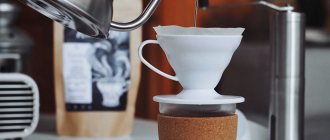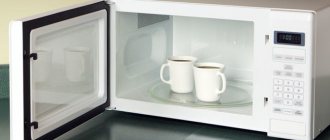Can I use a blender?
The design of a blender is in many ways similar to a blade coffee grinder. The main difference is the location of the knives at a higher level. Therefore, during operation, some of the grains become clogged under them. You have to periodically pause the process, stir the mixture or shake the bowl so that the stuck grains begin to move again. Accordingly, the procedure causes certain difficulties.
You can use the blender as a coffee grinder if you plan to brew the drink in a Turkish coffee pot.
It will not be possible to grind coffee beans for a coffee maker, since this brewing method requires smaller fractions.
How to grind grains in an immersion blender
If you want to prepare coffee powder yourself, and only use an immersion-type device at home, then you should prepare a special container in which the process will be carried out. Typically, such a cup with a tightly closing lid is sold complete with the unit. A small amount of aromatic grains is poured into a container, the metal leg of the blender is inserted, the lid must be closed and the grinding process begins.
If the bowl is lost or was not included in the kit, you will not be able to grind the grains. Some of the raw materials will get clogged under the cutting parts, the rest will scatter around the kitchen like coffee rain.
Preparing the device for grinding
A blender is not the best grinder for coffee beans. This method of grinding requires some preparation. Before you start grinding coffee, you need to do the following:
- Make sure there is a cover. If you carry out the process without this detail, the grains will scatter throughout the kitchen. After grinding is completed, you will have to spend a lot of time cleaning.
- Count the number of knives with which the unit is equipped . Only double knives with at least four cutting blades are suitable for grinding. If they are single, and there are only two blades, the desired result will not be achieved. Even if the motor is very powerful, the maximum that will be obtained is a coarse grind suitable for a French press.
- Wash and dry all parts of the device. Various products are ground in a blender. It is extremely important to ensure that there are no food residues or foreign odors before use. The presence of moisture during grinding is unacceptable.
Submersible device
Now let’s figure out whether it’s possible to grind immersion coffee in a blender. This device differs from the stationary one in that a special attachment with knives is immersed in the bowl.
To grind grains, choose a model with 4-6 foot blades, which are located at different heights. Also choose a narrow and tall bowl.
You need to grind grains with a submersible device like this:
- pour enough grains into the bowl so that after immersing the nozzle they do not completely cover the knives;
- choose the lowest power;
- periodically turn off the device, take out the nozzle and clean out the particles that are stuck in it.
When you finish grinding, thoroughly rinse and dry all parts of the device.
Differences between submersible and stationary
There are only two main types of blenders: stationary and immersion. Both options have a number of characteristic features, advantages and disadvantages that should be taken into account during operation.
Submersible
Grinding in a submersible device causes certain difficulties. To grind coffee in such a blender, you need to select a container with a closing lid in advance. Only in this case, part of the powder will not spill out.
When using this grinding device, you will have to periodically pause the process, remove the moving part of the structure and remove small particles stuck in it.
Stationary
It is quite possible to grind coffee in a stationary device of compact size. It will be difficult to grind grains in a large device. They will simply scatter throughout the bowl. Accordingly, grinding will take a lot of time.
The stationary unit has a great advantage. It is equipped with a lid that prevents the resulting fractions from spilling. In addition, it is possible to use a pulse mode. Thanks to this, the operation of the system is periodically suspended, which means there will be time to shake the bowl and move the grains closer to the knives.
Stationary device
Getting ready for work
If you had to grind coffee in a blender, use a stationary device with a small or narrow bowl. If the distance between the bottom, walls and knives is more than 5 millimeters, the grains will rarely fall under them and therefore will not be crushed.
Wash and dry all parts of the device. There should be no food residues or drops of water - this will spoil the taste and smell of the drink. Be sure to cover the bowl while working, otherwise the coffee beans will scatter throughout the kitchen.
Interesting! How to roast coffee beans at home
Check the quality of the knives . To properly grind coffee, choose double ones with four blades. If there are fewer, you won't even get a coarse grind.
Step-by-step instruction
Grinding grains is possible only if you follow the rules:
- select the lowest power;
- pour 50 grams of grains;
- turn on the device for a minute, turn it off and stir the coffee mass;
- Allow the device to cool for 1-2 minutes and repeat the previous step.
It is better to use pulse mode. If the device is operated for more than 1 minute, it will begin to heat up. Because of this, the drink will acquire an unpleasant burnt taste.
The last step is to wash all parts of the device to eliminate the smell. With this grinder you will get large particles. If you need a fine powder, place the coffee mixture in a cloth or plastic bag and work it over with a rolling pin or hammer.
Disadvantages of grinding in a blender
In principle, it is possible to grind coffee beans with a blender, but this method has a number of disadvantages. Among them are the following:
- When grinding grains regularly, the knives quickly become deformed. Additional funds will be required to replace them.
- When using a stationary device, the bowl may be damaged. The grains scratch the walls and microcracks appear. In addition, the container absorbs coffee aroma. This will affect the quality of other products crushed in the device.
- There is a risk of spoiling the grains. When grinding quickly, coffee overheats and acquires a burnt taste and aroma.
You should use a blender instead of a coffee grinder only in exceptional cases. It is strongly not recommended to systematically resort to such manipulations.
Which blenders can grind coffee?
Such a unit can be submersible or stationary. In the first case, the model consists of a special handle on which attachments are attached. To grind food, you need to make an effort and immerse the blender in a container with food. It is equipped with small knives. They can handle coffee beans, but when grinding, you must periodically stop and clean the device thoroughly, otherwise it will not be able to continue working.
Important! When using an immersion blender, be sure to add a lid. Otherwise, food will begin to jump out of the bowl and fly around the room.
The stationary model has a special bowl and a tight-fitting lid. The knives are located at the bottom of the container. The equipment is installed on the platform and you can start working. You can also grind coffee with this blender. But the grinding will be uneven due to the fact that the knives cannot reach the bottom of the bowl.
You can use both blender options to grind coffee beans. The main thing is that the model is equipped with special mill knives.
How else can you grind coffee?
There are a number of alternative options for grinding coffee beans:
- Mechanical mill. The device is designed for grinding herbs and spices. Sometimes it can be used to grind coffee. True, it will not be possible to obtain small fractions in this way.
- Meat grinder. Electrical and manual devices can be used. You should use knives that allow you to chop the product as finely as possible.
- Rolling pin. In order to obtain small fractions, the grains should be placed on a cloth and wrapped. Grinding is done by applying pressure with a rolling pin. True, this requires some effort.
- Hammer . It is used in a similar way to a rolling pin.
It is best to grind coffee in a coffee grinder, but you don’t always have one on hand. In such situations, a blender will come to the rescue. This kitchen unit is also capable of grinding coffee beans. The main thing is to avoid overheating during its operation. Otherwise, all your efforts will be in vain.
Grind coffee in a hand blender: 3 tips
To grind coffee without unnecessary problems, it is better to use a hand blender. I will give three tips for using this technique:
| Tip 1. Prepare all parts of the blender Before you start using it, you need to prepare and assemble all the parts of the blender. To grind coffee beans, it is better to use an attachment with the largest number of blades | |
| Tip 2. Pour the grains into a cup After assembling the blender, you need to pour a small amount of coffee beans into it. Then start grinding the product | |
| Tip 3: Grind on low power Grind grains only at low power. If you notice that the equipment is very hot, turn it off for 20 minutes, then start again. When finished, pour the coffee into a separate container. Clean and put away the blender |
Blender
Grinding coffee without a coffee grinder will not be difficult if you have a blender among your household appliances. It often comes with a grinder that allows you to achieve a medium grind size suitable for brewing in a coffee pot, French press or drip coffee maker.
Procedure:
- Pour no more than 100 g of coffee into the cup.
- Turn on the unit at short intervals, no more than 2-3 seconds.
- Shake the container periodically to ensure even grinding.
The chopper cannot be left on for long periods of time, as the rotating blades may overheat. Blenders, as a rule, are not designed for intensive work with solid products.
If the chopper is not included, then the immersion blender can be used separately. The beans are poured into a high-sided plastic cup and ground at low speed, pressing the knives against the surface of the coffee. In this case, you need to cover the container with a lid or hand so that the contents do not fly out.
A high-power stationary blender serves as a complete alternative to a coffee grinder. It must be turned on at more frequent intervals of 1-2 seconds. The grains in the unit will grind unevenly, so the container needs to be shaken vigorously from time to time. In this blender you can get medium-ground coffee in large volumes. Finally, the bowl and cutting parts must be thoroughly washed, adding a little soda to the detergent to get rid of the coffee aroma.
Manual methods
If you don’t have suitable kitchen equipment at your disposal, kitchen utensils or heavy tools will help you grind coffee without a coffee grinder.
Hammer
In this case, you will need a hammer with a heavy head and a board. The grains should be placed in a bag or under a layer of thick paper. It is convenient for this purpose to use packaging with a zipper, which are used for long-term storage of food or freezing. Dense polyethylene will not tear under mechanical stress, and the lock will prevent the coffee from spilling out.
Procedure:
- Spread the coffee in the bag into one layer.
- Use short, frequent, but not too strong blows to break the grains, shaking the bag periodically.
The result will be medium to coarse ground coffee. Grinding grains with a hammer does not take much time, but it is difficult to obtain a large volume this way.
rolling pin
The procedure is almost the same as in the case of a hammer. The grains should be placed in a tight bag, placed on a wooden board and evenly distributed in one layer. Then crush the coffee forcefully with a rolling pin, acting as if you were rolling out dough normally.
This method is only suitable as a last resort, since in most cases the grind will be too coarse. You can brew such coffee, but you will hardly be able to feel all the richness of taste and aroma.
Design Features
A blender is a device designed for grinding a variety of products, including quite hard ones. It handles tough vegetables and foods like nuts with ease. Based on this, it can be assumed that it will be able to grind coffee beans. If you compare its design and coffee grinders, you will find that they have similarities.
Some models of coffee grinders grind coffee using rapidly rotating blades, which is called torsion grinding. The chopping device of the blender is designed in a similar way. However, there is a slight difference. In it, the knives are located slightly higher than the base and much further from the walls. During operation of the device, the knives simply will not reach all the elements, leaving most of them untouched.
The knives will slide over the grains, cutting off some of them. In order to process the entire mass in the bowl, you will have to constantly shake it. In a coffee grinder, the cutting parts are located much closer to the bottom and walls, so they capture and gradually grind all the components inside. Its design allows for uniform fine grinding.
This will not work in a blender. At best, you will get unevenly ground coarse coffee. However, this composition can also be used for brewing a drink. Due to coarse, uneven grinding, the taste of the finished drink may change and its preparation will take longer. In addition, this operation has more disadvantages than advantages.
If you still decide to grind coffee using a blender, look at how the design of the knives looks. In order for the grind to be more or less suitable for brewing, you need double knives with four working surfaces. However, keep in mind that it will still not be uniform.
Can a blender replace a mixer?
Both options are fundamentally different techniques. If we talk specifically about replacement, then the blender can only be compared with a hand mixer, but due to its low power, the range of its tasks will be limited. The job of a blender is to grind, and the job of a mixer is to mix.
However, manufacturers produce blenders with various attachments, for example, in the form of a whisk. That is, the working element changes and the device becomes multifunctional. True, such a technique will not be able to handle heavy, thick dough. And high loads can lead to earlier failure.
If you need to choose between a blender or a mixer for your home, it is best to choose both options. Each technique is tailored for a specific process.
Areas of use
A blender in the kitchen is at the same time a meat grinder, a chopper, a mixer, and a food processor. That is, you don’t need to have 4 different devices, you can replace everything with one compact device. It is very comfortable.
The main purpose of these units is domestic use. But sometimes they are also used by professional chefs in the kitchens of restaurants and cafes. They need them to prepare delicious desserts and snacks.
This device can be safely used for chopping raw or boiled vegetables, and you can also easily grind meat and fish in a blender.
Please note that what you use the device for will determine how it should work. For example, if you need to grind dry or hard products, then always let the device rest
Because if the motor runs continuously, it will get very hot and burn out from overload.
You can use an immersion blender not only to process products in the bowl that comes with it, but also in any other container that seems convenient for you.
Do not puree the soup immediately after removing it from the stove. Of course, the blender is not afraid that it is hot, but the knives can quickly become dull during such work. The same should be done with a stationary device. The material from which it is made can become dark when hot, and there is no way to clean it off.











